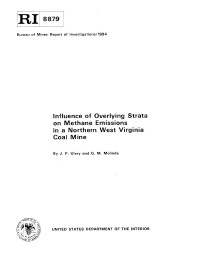Mining Publication: Influence of Overlying Strata on Methane Emissions in a Northern West Virginia Coal Mine
Original creation date: January 1984
Authors: JP Ulery, GM Molinda
NIOSHTIC2 Number: 10003953
Pittsburgh, PA: U.S. Department of the Interior, Bureau of Mines, RI 8879, 1984 Jan; :1-14
Since 1970, abnormally high methane emissions have been observed in eastern sections of the Federal No. 2 Mine operating in the Pittsburgh coalbed in northern West Virginia. The nature and volume of these emissions indicate a source other than the coalbed. An investigation was undertaken to delineate probable methane sources. Gas well information and stratigraphic correlation of corehole data indicate that a sandstone directly above the main coalbed is an additional source of methane emissions. The sandstone body appears to be an ancient stream channel, infilled with fine-grained sand and organic matter. Coalification of the organic matter produced methane as a byproduct. Additional methane presumably migrated into the sandstone unit from the subjacent coalbeds. The methane became trapped in the porous clastic unit by the surrounding impermeable strata. Mine development near this unit creates a significant pressure gradient, triggering abnormal methane emissions into the mine along naturally occurring fractures. Predevelopment methane drainage of the sandstone could be accomplished by completing vertical boreholes along its trend.

NIOSHTIC2 Number: 10003953
Pittsburgh, PA: U.S. Department of the Interior, Bureau of Mines, RI 8879, 1984 Jan; :1-14
- Development and Application of Reservoir Models and Artificial Neural Networks for Optimizing Ventilation Air Requirements in Development Mining of Coal Seams
- Guidelines for the Control and Monitoring of Methane Gas on Continuous Mining Operations
- Managing Excess Gas Emissions Associated with Coal Mine Geologic Features
- Methane Control by Isolation of a Major Coal Panel - Pittsburgh Coalbed
- Methane Emission Rate Studies in a Northern West Virginia Mine
- Methane Emissions from Four Working Places in the Beckley Mine, Raleigh County, W. Va.
- Modeling and Prediction of Ventilation Methane Emissions of U.S. Longwall Mines Using Supervised Artificial Neural Networks
- Remote Methane Sensors
- Reservoir Rock Properties of Coal Measure Strata of the Lower Monongahela Group, Greene County (Southwestern Pennsylvania), from Methane Control and Production Perspectives
- Rotary Drilling Techniques Used in the Beckley Coalbed